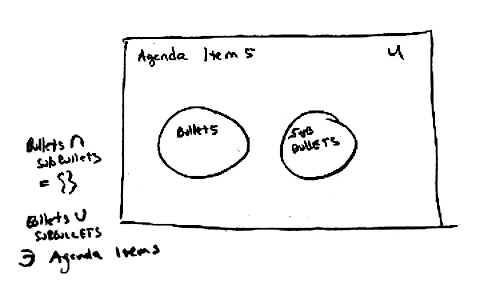Agenda Items
A major area of the systems engineers responsibility at Honeywell lay in the preparation of view graph material for presentation to the customer. Under the guidance of veteran Jim Gray (see note 1), e quickly mastered the technique.
Given his extensive experience, it was natural for e to lay the theoretical groundwork for partitioning agenda items into bullets and sub-bullets. To minimize the often lengthy and heated debates as to whether a specific topic fell into one category or the other, e developed a heuristic selection algorithm. Below we see an early example of his thought process. U is the universe of all agenda items. We see it broken in two Venn disks representing bullets and sub-bullets.

Note that e had already derived the fact that the intersection of the two Venn disks (Bullets and Sub-bullets) is the null set. Further insight is gained by noting his cryptic note to the effect that the union of Bullets and Sub-bullets is an element of the set of Agenda Items - with the subtle indication that there are other, unidentified elements present. This observation forms the basis for pundit's claims that e's work presaged Godel's theorem on incomplete sets. While perhaps obvious, e's work codified these facts and established the framework on which all of today's view graph presentations are based.
Note 1 - Jim Gray began work at Honeywell in 1953, the year e was born.
